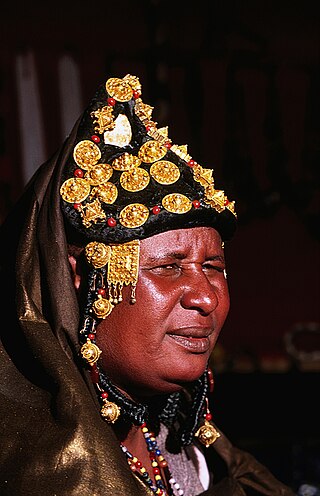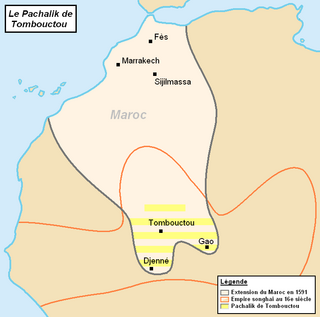Related Research Articles

The Songhai Empire was a state located in the western part of the Sahel during the 15th and 16th centuries. At its peak, it was one of the largest African empires in history. The state is known by its historiographical name, derived from its largest ethnic group and ruling elite, the Songhai people. Sonni Ali established Gao as the empire's capital, although a Songhai state had existed in and around Gao since the 11th century. Other important cities in the kingdom were Timbuktu and Djenné, where urban-centred trade flourished; they were conquered in 1468 and 1475, respectively. Initially, the Songhai Empire was ruled by the Sonni dynasty, but it was later replaced by the Askia dynasty (1493–1591).

The Songhai people are an ethnolinguistic group in West Africa who speak the various Songhai languages. Their history and lingua franca is linked to the Songhai Empire which dominated the western Sahel in the 15th and 16th century. Predominantly adherents of Islam, the Songhai are primarily located in Niger and Mali. Historically, the term "Songhai" did not denote an ethnic or linguistic identity but referred to the ruling caste of the Songhay Empire known as the Songhaiborai. However, the correct term used to refer to this group of people collectively by the natives is "Ayneha". Although some speakers in Mali have also adopted the name Songhay as an ethnic designation, other Songhay-speaking groups identify themselves by other ethnic terms such as Zarma or Isawaghen. The dialect of Koyraboro Senni spoken in Gao is unintelligible to speakers of the Zarma dialect of Niger, according to at least one report. The Songhay languages are commonly taken to be Nilo-Saharan but this classification remains controversial: Dimmendaal (2008) believes that for now it is best considered an independent language family.

Askia Muhammad Ture I (1443–1538), born Muhammad ibn Abi Bakr al-Turi or Muhammad Ture, was the first ruler of the Askia dynasty of the Songhai Empire, reigning from 1493 to 1528. He is also known as Askia the Great, and his name in modern Songhai is Mamar Kassey. Askia Muhammad strengthened his empire and made it the largest empire in West Africa's history. At its peak under his reign, the Songhai Empire encompassed the Hausa states as far as Kano and much of the territory that had belonged to the Songhai empire in the east. His policies resulted in a rapid expansion of trade with Europe and Asia, the creation of many schools, and the establishment of Islam as an integral part of the empire.

Sankoré Madrasa is one of three medieval mosques and centres of learning located in Timbuktu, Mali, the others being the Djinguereber and Sidi Yahya mosques. Founded in the 14th century, the Sankoré mosque went through multiple periods of patronage and renovation under both the Mali Empire and the Songhai Empire until its decline following the Battle of Tondibi in 1591. The mosque developed into a madrasa, reaching its peak in the 16th century.
Askia Ishaq II, also known as Askia Isḥāq Zughrānī, was the ruler of the Songhai Empire from 1588 to 1591. He commanded the Songhai force at the Battle of Tondibi, where he was defeated by Saadian forces from Morocco who subsequently destroyed the empire.
Askia Mohammad Benkan, also Askiya Muhammad Bonkana Kirya, was the third ruler of the Songhai Empire from 1531 to 1537.
The Dendi was a former province of the Songhai Empire. It survived the fall of the Empire as a kingdom until 1901, when it was conquered by France and incorporated into French West Africa. Its centers today are the cities of Gaya in Niger, Kamba in Nigeria and Malanville in Benin.
Askia Musa or Askiya Musa was the second Askia ruler of the Songhai Empire.
Mohammed Bagayogo Es Sudane Al Wangari Al Timbukti was an eminent scholar from Timbuktu, Mali. Baghayogho originated from among the Juula people, who are a Mande ethnic group composed of merchants and scholars.
The Askiya dynasty, also known as the Askia dynasty, ruled the Songhai Empire at the height of that state's power. It was founded in 1493 by Askia Mohammad I, a general of the Songhai Empire who usurped the Sonni dynasty. The Askiya ruled from Gao over the vast Songhai Empire until its defeat by a Moroccan invasion force in 1591. After the defeat, the dynasty moved south back to its homeland and created several smaller kingdoms in what is today Songhai in south-western Niger and further south in the Dendi.
The University of Timbuktu is a collective term for the teaching associated with three mosques in the city of Timbuktu in what is now Mali: the mosques of Sankore, Djinguereber, and Sidi Yahya. It was an organized scholastic community that endured for many centuries during the medieval period. The university contributed to the modern understanding of Islamic and academic studies in West Africa during the medieval period and produced a number of scholars and manuscripts taught under the Maliki school of thought.
Askia Ishaq I, also known as Ishaq Ber, was the ruler of the Songhai Empire from 1539 to 1549, elected Askia following the death of Askia Isma'il. He was the fifth ruler of the Askiya dynasty.

The Pashalik of Timbuktu, also known as the Pashalik of Sudan, was a West African political entity that existed between the 16th and the 19th century. It was formed after the Battle of Tondibi, when a military expedition sent by Saadian sultan Ahmad al-Mansur of Morocco defeated the Songhai Empire and established control over a territory centered on Timbuktu. Following the decline of the Saadi Sultanate in the early 17th century, Morocco retained only nominal control of the Pashalik.
Askia Ismail was the sixth ruler of the Songhai Empire from 1537 – 1539, and fourth from the Askia dynasty. He was the son of Askia Mohammad I, the founder of the Askia dynasty, and Maryam Daabu, a member of the Malian royal family captured in 1501.
Askia Daoud was the ruler of the Songhai Empire from 1549 to 1582. His rule saw the empire rise to a peak of peace and prosperity following a series of succession disputes and short reigns.
The Moroccan invasion of the Songhai Empire began with an expedition sent in 1590 by Sultan Ahmad al-Mansur of the Saadian dynasty, which ruled over Morocco at the time. The Saadian army, led by Judar Pasha, arrived in the Niger valley region in 1591 and won its first and most decisive victory against the forces of Askia Ishaq II at the Battle of Tondibi and occupied the capital of Gao shortly after.
Askia Muhammad Bani was the ruler of the Songhai Empire from 1586 to 1588. A son of Askia Daoud, he was elevated by his brothers after they had deposed Askia Al-Hajj, his predecessor.
Askia Muhammad Gao was the last ruler of the Songhai Empire. A son of Askia Daoud, he assumed power in the last months of 1591 after the defeat of Askia Ishaq II by Moroccan forces at the Battle of Tondibi and the subsequent Battle of Bamba. About forty days after taking power he was lured into a trap by Moroccans, captured, and later executed.
Umar Komajago, also spelled Konjaago, Komadiaga and many other variants, was the Kanfari, or ruler of the western provinces, of the Songhai Empire under his brother Askia Mohammad I from 1494 until his death in 1520.
The Kurmina-fari or Kanfari was the title of a major administrative and military position in the Songhai Empire. The position was broadly in charge of the western half of the empire, and was based in Tindirma. The position was created by Askia Mohammad I in 1494 soon after he took power from Sonni Ali. His brother Umar Komadiago was the first Kurmina-fari, and several of his sons would hold the position after him. The Kurmina-fari was often the eldest son or brother of the ruling Askia.
References
- 1 2 3 4 5 6 7 8 Gomez, Michael (2018). African dominion : a new history of empire in early and medieval West Africa. Princeton, NJ: Princeton University Press. ISBN 9780691177427.
- 1 2 Levtzion, Nehemiah (1977). "5 - The western Maghrib and Sudan". In Oliver, Ronald (ed.). The Cambridge History of Africa Volume 3: From c.1050 to c.1600. Cambridge University Press. p. 439. ISBN 9781139054577 . Retrieved 12 March 2024.